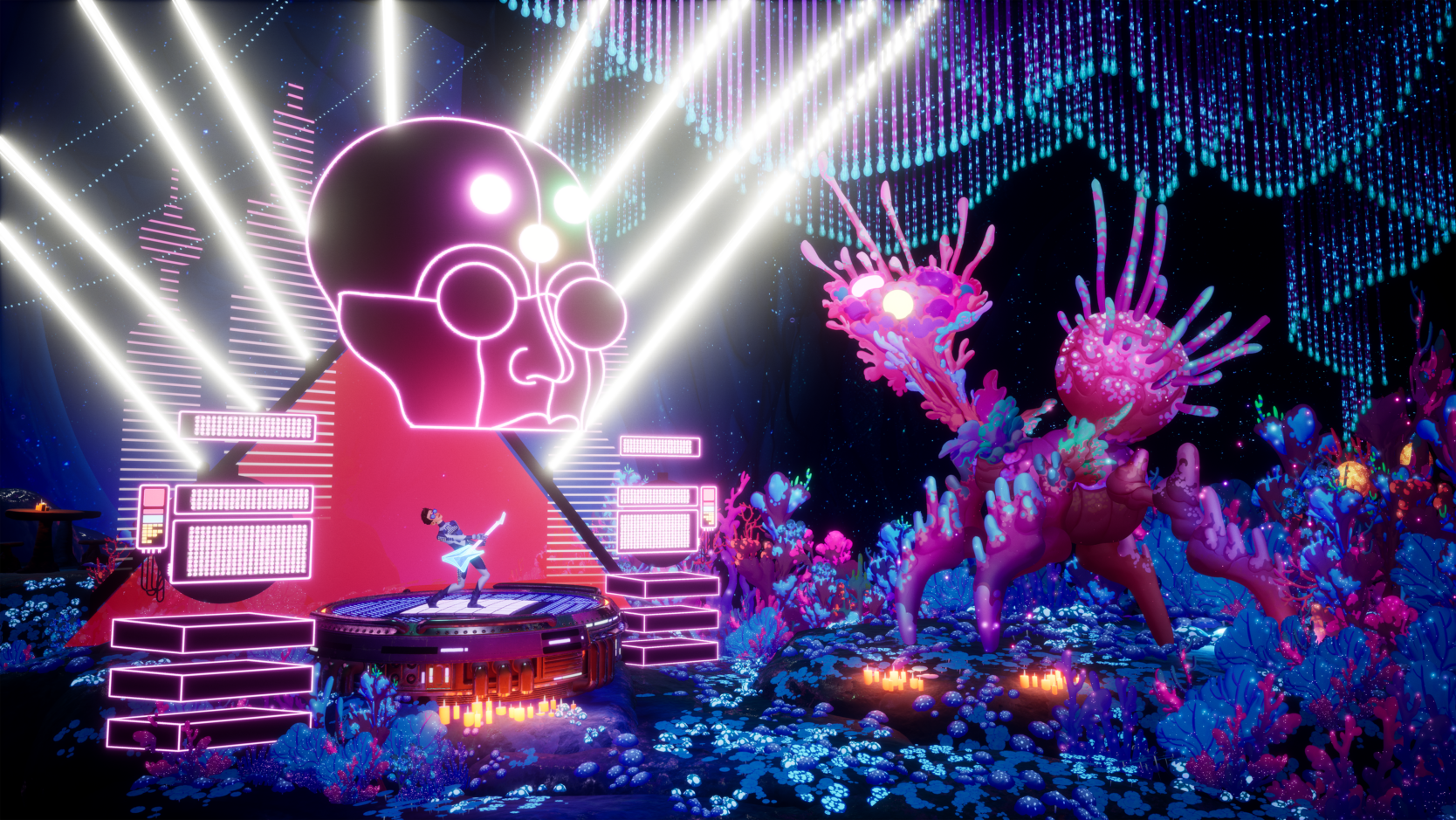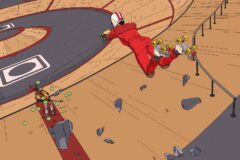There’s no shortage of video games that want to bring music to the forefront, but few (or none) of them do it quite like The Artful Escape.
With a storyline centered around music, gameplay that intentionally feels more like the badassery of a concert than the challenge of a video game, and enough classic rock references to please your burnout uncle who thinks video games are for children, The Artful Escape is almost music-focused to a fault.
Of course, a title that unique (and published by the indie giant Annapurna Interactive) couldn’t be made by traditional developers. Instead, it was directed by Johnny Galvatron (of Australian rock band, The Galvatrons) and his crew at Beethoven & Dinosaur, while the music was put together by producer/writer/artist Josh Abrahams and guitarist Eden Altman.
With The Artful Escape’s recent release on PlayStation and Switch (it already earned multiple award nominations for its 2021 release on Xbox and PC), SPIN spoke with the Australian trio about what went into bringing rock music and video games together like never before.
SPIN: Seeing as The Artful Escape released on PlayStation and Switch this week, what was it like to bring it to people this time around compared to the first release?
Johnny Galvatron: Instead of a mad dash, it’s more of a moonwalk across the finish line this time. All the reviews are out and everyone already has a view of the game, so I feel like this is just walking into another garden. I’m totally fine with it. It’s been really easy — especially for the art team where you don’t have to do anything. I’m totally excited for people to play it on PlayStation and Switch, and I think it’s going to be a good title for both. It’s lovely to see it on the ridiculous specs in the PS5, and it’s good to see it in the cool little handheld screen of the Switch.
A lot of games like to talk about the importance of music, but few actually center around music like The Artful Escape does. How did you go about fusing the music world into a video game so thoroughly?
Galvatron: It’s something that sits in between an album, a game and a film for me. It’s something that hovers about in a weird space, which I think is why people on the musical spectrum of things really got into it. There’s a lot of music games I really enjoy, but I don’t know if any of them really feel like playing music. When you’re playing music, there’s a list of songs that you can play effortlessly — like you don’t really think about what you’re playing when you play “Smells Like Teen Spirit” — and there’s a sense of power in there. I think what’s cool about The Artful Escape is being able to contribute to the music and be that virtuoso within big, epic symphonic tracks, and I think there’s something immensely satisfying about that.
Considering that you all come from a musical background, how did that connection affect your work together on this project?
Galvatron: Well, Josh and I have worked together since I was a wee child. He walked up to my door one day and said, “I heard you making some weird Van Halen shit.” I was like “What are you doing here, Josh Abrahams of ‘Addicted to Bass’ fame?” Josh had this big worldwide hit and was this big superstar, so it was so dope to hang out. Josh has been my favorite collaborator through my whole artistic career. We have a really amazing working relationship. Just to be able to sit for weeks on end in a studio and come up with this crazy alien music was an absolute treat, an honor and a privilege.
Josh Abrahams: Mainly because I make such a great toasted cheese sandwich. The music is all just like sprinkles on top. But we also had pretty much the Excalibur of session musicians in Eden, who really made the job easy for us. It’s effortless when he comes in, you give him the track and it’s “Off you go. Go and do your magic.” He plugs in his guitar and there’s this [sword unsheathing noise] and it becomes a sci-fi adventure.
Eden Altman: I’ve been collaborating with Josh since I was a wee child too, so it’s not hard at all when you’ve known the people for so long. There are no precious moments with anybody because our egos are left behind.
In addition to the music, you’ve got some huge names doing voice acting in the game. How did it feel to bring in people like Carl Weathers and Lena Headey for this?
Galvatron: It was weird and slightly terrifying, but ultimately an experience that I’ll always treasure. Annapurna obviously has a lot of ties in the film world, so they were like “Who do you want to play Lightman?” I’m like “Well who can I have? What’s the ceiling?” They said if I could have anyone, and I said Carl Weathers. A week later, they called us up like “Carl’s in,” and then Carl’s in the studio booth saying all this nonsense that you wrote, never thinking you would have to show it to some quality actors. All of the actors we worked with were just joys to work with. I mean, Carl Weathers is intimidating. I thought if anyone could punch you through a webcam, it’s probably Carl. But he was just adding lines and helping me to use a better lexicon for funk and jazz artists from the ‘70s. Then Lena Headey comes in — and I’m obviously still very intimidated — and she just did like 15 accents and asked us which ones we want. I’m a huge fan of Jason [Schwartzman], and I got to hang out with him and just talk for a couple of hours about Bob Dylan and David Bowie. It was just absolute dream stuff.
From a gameplay perspective, The Artful Escape probably involves more focus on guitars than anything since Guitar Hero. What went into bringing the guitar to life like this within a video game?
Altman: I think a lot of it has to do with Johnny’s direction. He would call me up and say, “Today, we’re going to do this or be like this amazing artist.” As the guitar player, it started to sink in about two years into the project where I realized that the guitar and I were going to be the star of the show. Johnny was saying that to me the whole time, but it didn’t really sink in right away. There were times — like during the final solo — where we had to watch the footage and sort of just feel what to play whilst watching, almost like doing a traditional score.
There are a lot of rock and roll references within The Artful Escape even beyond the base gameplay. How did you decide what to stuff in there?
Galvatron: I spent my whole life listening to all this crazy music and watching the associated visuals, so it felt to me like a trolley dash. It was just like running through the store like, “I’m gonna have some Van Halen. I’m gonna add some Joe Satriani. I’m gonna put some KISS in there.” I have so much love for them and have been on so many crazy rock and roll adventures of my own that it was a joy to come up with that stuff. Josh and I have very similar stories actually, and I think all of the heartfelt stuff in there about how hard it is to create and everything was just what we had seen in the music scene and how strange the expectations are.
Abrahams: As far as adding other music, a lot of the backing tracks and the references Johnny brought to me were orchestral film scores that we then inserted Van Halen over.
Galvatron: People don’t Van Halen enough over film scores enough — that’s what I think. There’s an operatic side to rock and roll, which is something that I was always drawn to. One of the main themes of the game is the satellite aspects that surround your creative medium. It’s not just the music, but how you dress, the imagery and videos associated with it. Also, there’s a shop in the game that sells plants and books. It’s called “Plant and Page,” and no one ever notices it. Please look at my little Led Zeppelin easter egg. It brings me great joy.





